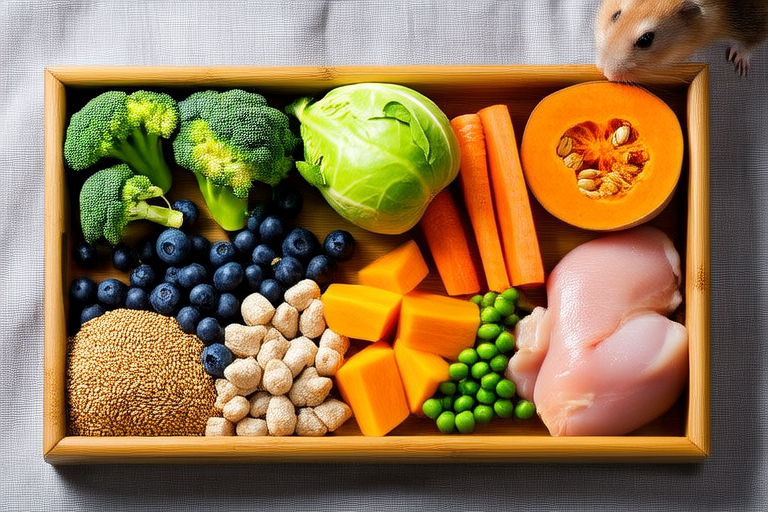Top 10 Foods That Will Make Your Golden Hamster Thrive
Welcome to the wonderful world of golden hamster care! These cute, furry creatures have specific dietary needs that, when met, can ensure they live long, healthy lives. A balanced diet for a golden hamster should consist primarily of high-quality commercial hamster pellets, supplemented with fresh fruits, vegetables, grains, and occasional proteins. It’s important to note that while these pets are small, their nutritional requirements are diverse. This article will guide you through the top 10 foods that will make your golden hamster thrive.
Introduction: The Dietary Needs of Golden Hamsters
Golden hamsters are omnivores, meaning they eat both plant and animal matter. In the wild, they consume seeds, nuts, insects, and other small animals. When kept as pets, however, their diet should be carefully managed to mimic this balance while ensuring safety and nutrition. The primary goal is to provide them with essential nutrients such as vitamins, minerals, fats, and proteins.
1. Timothy Hay
Nutritional Benefits: Timothy hay is rich in fiber, which aids digestion and helps maintain dental health by naturally wearing down their continuously growing teeth.
Recommended Serving Size: Unlimited.
Frequency: Timothy hay should be available at all times. It serves as both a source of nutrition and enrichment for your hamster.
Preparation Tips: Fresh timothy hay is best. Avoid hay that is moldy or has been exposed to pesticides.
2. Apples
Nutritional Benefits: Apples are a good source of vitamin C and fiber, promoting a healthy immune system and aiding digestion.
Recommended Serving Size: One small slice.
Frequency: Once a week.
Preparation Tips: Remove seeds and core before offering. Wash thoroughly to remove any pesticides.
3. Carrots
Nutritional Benefits: High in beta-carotene (converted to vitamin A), carrots support vision and overall health.
Recommended Serving Size: Half a teaspoon.
Frequency: Twice a week.
Preparation Tips: Cooked carrots are easier for hamsters to digest than raw ones. Cut into tiny pieces to prevent choking.
4. Green Peas
Nutritional Benefits: Packed with protein, fiber, and vitamins A and C, green peas offer a well-rounded nutrient profile.
Recommended Serving Size: Three small peas.
Frequency: Twice a week.
Preparation Tips: Serve cooked and cooled. Avoid adding salt or seasonings.
5. Sunflower Seeds
Nutritional Benefits: High in fat and protein, sunflower seeds provide energy and help maintain skin and coat health.
Recommended Serving Size: One seed.
Frequency: Once a week.
Preparation Tips: Offer unsalted and unhulled seeds. Too many can lead to obesity or digestive issues.
6. Blueberries
Nutritional Benefits: Rich in antioxidants and vitamin C, blueberries enhance the immune system and promote heart health.
Recommended Serving Size: Two berries.
Frequency: Once every two weeks.
Preparation Tips: Rinse thoroughly and remove stems. Freeze berries slightly to make them easier to handle.
7. Quinoa
Nutritional Benefits: A complete protein containing all nine essential amino acids, quinoa supports muscle development and repair.
Recommended Serving Size: One teaspoon.
Frequency: Once a week.
Preparation Tips: Cook until soft and serve cool. Mix with pellets for variety.
8. Hard-boiled Egg
Nutritional Benefits: Eggs are an excellent source of protein and essential fatty acids, crucial for growth and maintenance.
Recommended Serving Size: One small piece.
Frequency: Once every two weeks.
Preparation Tips: Peel and cut into tiny pieces. Discard shell and yolk if your hamster shows no interest.
9. Pumpkin Seeds
Nutritional Benefits: High in zinc and magnesium, pumpkin seeds contribute to immune function and bone health.
Recommended Serving Size: One seed.
Frequency: Once a week.
Preparation Tips: Serve raw and unshelled. Monitor closely for any signs of choking.
10. Oats
Nutritional Benefits: Oats are a good source of fiber and complex carbohydrates, providing sustained energy.
Recommended Serving Size: One teaspoon.
Frequency: Once a week.
Preparation Tips: Cook oats until soft. Let them cool completely before serving.
Warnings About Harmful Foods to Avoid
Some foods can be toxic or harmful to your golden hamster. These include chocolate, caffeine, citrus fruits, avocado, and dairy products. Always research new foods before introducing them to your pet’s diet.
Maintaining a Balanced Diet for Your Pet Hamster
To keep your golden hamster healthy, aim for a varied diet that includes a mix of pellets, hay, and occasional treats. Regularly monitor their weight and adjust portion sizes accordingly. Remember, moderation is key. While treats are enjoyable, they should not replace a balanced diet of pellets and hay.
In conclusion, providing a nutritious and varied diet is one of the best ways to ensure your golden hamster leads a happy and healthy life. By following the guidelines outlined in this article, you’ll be well on your way to giving your pet the best possible care.
